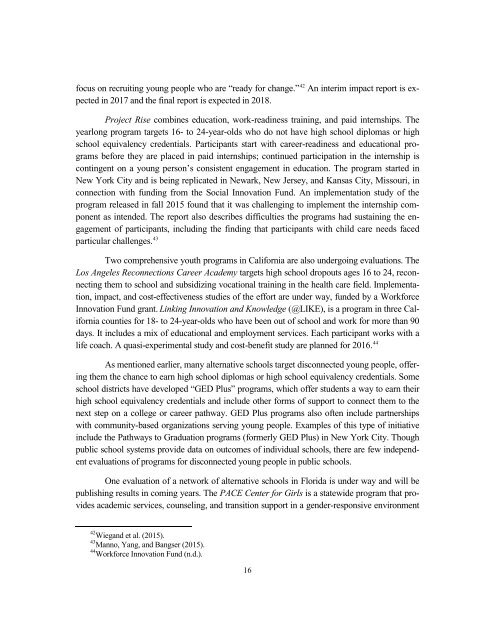Opportunity Youth: Disenfranchised Young People
Opportunity Youth: Disenfranchised Young People
Opportunity Youth: Disenfranchised Young People
Create successful ePaper yourself
Turn your PDF publications into a flip-book with our unique Google optimized e-Paper software.
focus on recruiting young people who are “ready for change.” 42 An interim impact report is expected<br />
in 2017 and the final report is expected in 2018.<br />
Project Rise combines education, work-readiness training, and paid internships. The<br />
yearlong program targets 16- to 24-year-olds who do not have high school diplomas or high<br />
school equivalency credentials. Participants start with career-readiness and educational programs<br />
before they are placed in paid internships; continued participation in the internship is<br />
contingent on a young person’s consistent engagement in education. The program started in<br />
New York City and is being replicated in Newark, New Jersey, and Kansas City, Missouri, in<br />
connection with funding from the Social Innovation Fund. An implementation study of the<br />
program released in fall 2015 found that it was challenging to implement the internship component<br />
as intended. The report also describes difficulties the programs had sustaining the engagement<br />
of participants, including the finding that participants with child care needs faced<br />
particular challenges. 43<br />
Two comprehensive youth programs in California are also undergoing evaluations. The<br />
Los Angeles Reconnections Career Academy targets high school dropouts ages 16 to 24, reconnecting<br />
them to school and subsidizing vocational training in the health care field. Implementation,<br />
impact, and cost-effectiveness studies of the effort are under way, funded by a Workforce<br />
Innovation Fund grant. Linking Innovation and Knowledge (@LIKE), is a program in three California<br />
counties for 18- to 24-year-olds who have been out of school and work for more than 90<br />
days. It includes a mix of educational and employment services. Each participant works with a<br />
life coach. A quasi-experimental study and cost-benefit study are planned for 2016. 44<br />
As mentioned earlier, many alternative schools target disconnected young people, offering<br />
them the chance to earn high school diplomas or high school equivalency credentials. Some<br />
school districts have developed “GED Plus” programs, which offer students a way to earn their<br />
high school equivalency credentials and include other forms of support to connect them to the<br />
next step on a college or career pathway. GED Plus programs also often include partnerships<br />
with community-based organizations serving young people. Examples of this type of initiative<br />
include the Pathways to Graduation programs (formerly GED Plus) in New York City. Though<br />
public school systems provide data on outcomes of individual schools, there are few independent<br />
evaluations of programs for disconnected young people in public schools.<br />
One evaluation of a network of alternative schools in Florida is under way and will be<br />
publishing results in coming years. The PACE Center for Girls is a statewide program that provides<br />
academic services, counseling, and transition support in a gender-responsive environment<br />
42 Wiegand et al. (2015).<br />
43 Manno, Yang, and Bangser (2015).<br />
44 Workforce Innovation Fund (n.d.).<br />
16

















